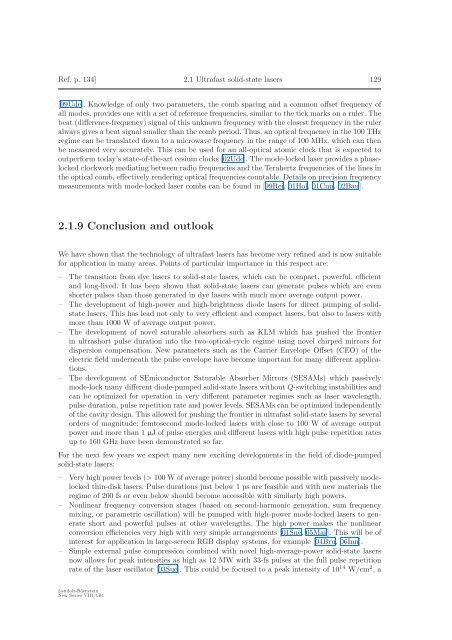2.1 Ultrafast solid-state lasers - ETH - the Keller Group
2.1 Ultrafast solid-state lasers - ETH - the Keller Group
2.1 Ultrafast solid-state lasers - ETH - the Keller Group
Create successful ePaper yourself
Turn your PDF publications into a flip-book with our unique Google optimized e-Paper software.
Ref. p. 134] <strong>2.1</strong> <strong>Ultrafast</strong> <strong>solid</strong>-<strong>state</strong> <strong>lasers</strong> 129<br />
[99Ude]. Knowledge of only two parameters, <strong>the</strong> comb spacing and a common offset frequency of<br />
all modes, provides one with a set of reference frequencies, similar to <strong>the</strong> tick marks on a ruler. The<br />
beat (difference-frequency) signal of this unknown frequency with <strong>the</strong> closest frequency in <strong>the</strong> ruler<br />
always gives a beat signal smaller than <strong>the</strong> comb period. Thus, an optical frequency in <strong>the</strong> 100 THz<br />
regime can be translated down to a microwave frequency in <strong>the</strong> range of 100 MHz, which can <strong>the</strong>n<br />
be measured very accurately. This can be used for an all-optical atomic clock that is expected to<br />
outperform today’s <strong>state</strong>-of-<strong>the</strong>-art cesium clocks [02Ude]. The mode-locked laser provides a phaselocked<br />
clockwork mediating between radio frequencies and <strong>the</strong> Terahertz frequencies of <strong>the</strong> lines in<br />
<strong>the</strong> optical comb, effectively rendering optical frequencies countable. Details on precision frequency<br />
measurements with mode-locked laser combs can be found in [99Rei, 01Hol, 01Cun, 02Bau].<br />
<strong>2.1</strong>.9 Conclusion and outlook<br />
We have shown that <strong>the</strong> technology of ultrafast <strong>lasers</strong> has become very refined and is now suitable<br />
for application in many areas. Points of particular importance in this respect are:<br />
– The transition from dye <strong>lasers</strong> to <strong>solid</strong>-<strong>state</strong> <strong>lasers</strong>, which can be compact, powerful, efficient<br />
and long-lived. It has been shown that <strong>solid</strong>-<strong>state</strong> <strong>lasers</strong> can generate pulses which are even<br />
shorter pulses than those generated in dye <strong>lasers</strong> with much more average output power.<br />
– The development of high-power and high-brightness diode <strong>lasers</strong> for direct pumping of <strong>solid</strong><strong>state</strong><br />
<strong>lasers</strong>. This has lead not only to very efficient and compact <strong>lasers</strong>, but also to <strong>lasers</strong> with<br />
more than 1000 W of average output power.<br />
– The development of novel saturable absorbers such as KLM which has pushed <strong>the</strong> frontier<br />
in ultrashort pulse duration into <strong>the</strong> two-optical-cycle regime using novel chirped mirrors for<br />
dispersion compensation. New parameters such as <strong>the</strong> Carrier Envelope Offset (CEO) of <strong>the</strong><br />
electric field underneath <strong>the</strong> pulse envelope have become important for many different applications.<br />
– The development of SEmiconductor Saturable Absorber Mirrors (SESAMs) which passively<br />
mode-lock many different diode-pumped <strong>solid</strong>-<strong>state</strong> <strong>lasers</strong> without Q-switching instabilities and<br />
can be optimized for operation in very different parameter regimes such as laser wavelength,<br />
pulse duration, pulse repetition rate and power levels. SESAMs can be optimized independently<br />
of <strong>the</strong> cavity design. This allowed for pushing <strong>the</strong> frontier in ultrafast <strong>solid</strong>-<strong>state</strong> <strong>lasers</strong> by several<br />
orders of magnitude: femtosecond mode-locked <strong>lasers</strong> with close to 100 W of average output<br />
power and more than 1 μJ of pulse energies and different <strong>lasers</strong> with high pulse repetition rates<br />
up to 160 GHz have been demonstrated so far.<br />
For <strong>the</strong> next few years we expect many new exciting developments in <strong>the</strong> field of diode-pumped<br />
<strong>solid</strong>-<strong>state</strong> <strong>lasers</strong>:<br />
– Very high power levels (> 100 W of average power) should become possible with passively modelocked<br />
thin-disk <strong>lasers</strong>. Pulse durations just below 1 ps are feasible and with new materials <strong>the</strong><br />
regime of 200 fs or even below should become accessible with similarly high powers.<br />
– Nonlinear frequency conversion stages (based on second-harmonic generation, sum frequency<br />
mixing, or parametric oscillation) will be pumped with high-power mode-locked <strong>lasers</strong> to generate<br />
short and powerful pulses at o<strong>the</strong>r wavelengths. The high power makes <strong>the</strong> nonlinear<br />
conversion efficiencies very high with very simple arrangements [01Sue, 05Mar]. This will be of<br />
interest for application in large-screen RGB display systems, for example [04Bru, 06Inn].<br />
– Simple external pulse compression combined with novel high-average-power <strong>solid</strong>-<strong>state</strong> <strong>lasers</strong><br />
now allows for peak intensities as high as 12 MW with 33-fs pulses at <strong>the</strong> full pulse repetition<br />
rate of <strong>the</strong> laser oscillator [03Sue]. This could be focused to a peak intensity of 10 14 W/cm 2 ,a<br />
Landolt-Börnstein<br />
New Series VIII/1B1
















